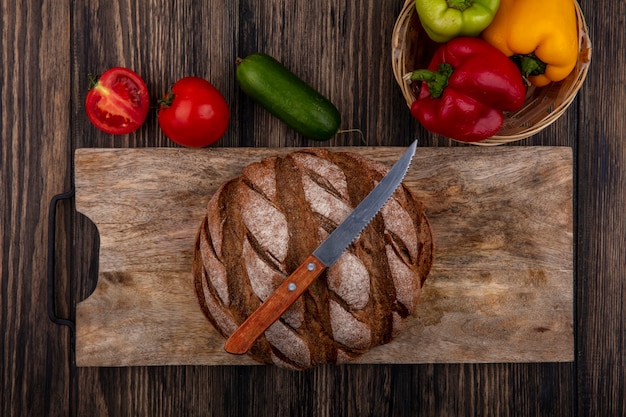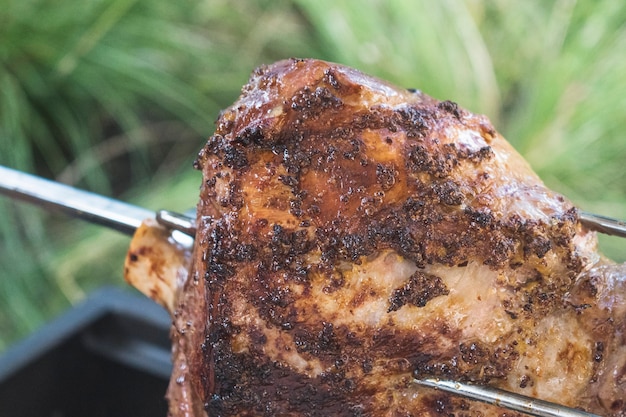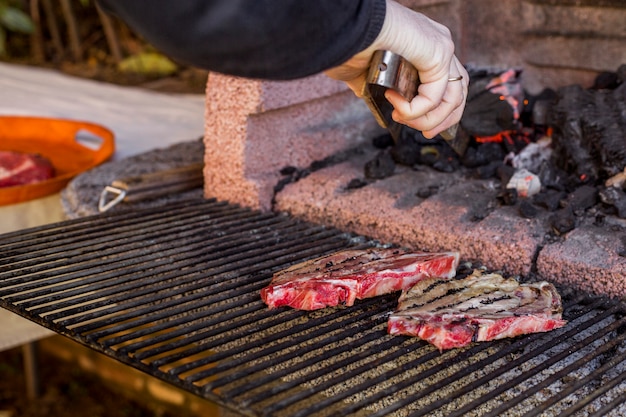Oh, the T-bone steak. The king of the grill, the star of the barbecue, the epitome of meaty deliciousness. There's just something so satisfying about sinking your teeth into a perfectly cooked T-bone, with its juicy, tenderloin side and the hearty, flavorful strip steak, all separated by that iconic T-shaped bone. But achieving that coveted medium-rare finish, that beautiful pink center with a delicious sear, can feel like a culinary tightrope walk. Fear not, my fellow steak enthusiasts! I've spent countless hours in the kitchen, experimenting and perfecting my technique, and I'm here to share my secrets with you. This comprehensive guide is your ultimate cheat sheet to grilling the most delicious medium-rare T-bone steak, guaranteed to impress your friends and family.
(Part 1) Understanding the T-Bone Cut: A Culinary Icon

Let's start with the star of the show, the T-bone steak itself. You know, the kind that makes you drool just thinking about it. But there's more to this cut than meets the eye. It's a real charmer, combining the best of two worlds – the tenderloin (or filet mignon), known for its delicate texture and rich flavor, and the strip steak, boasting a bolder, more robust flavor. That "T" is formed by the T-shaped bone that separates the two muscles, making it an elegant and delicious centerpiece for any meal.
T-Bone Anatomy: A Closer Look
Think of the T-bone like a culinary puzzle. On one side of the bone lies the tenderloin, a luxurious, lean cut that melts in your mouth. It's the star of fancy restaurants and a favorite for its delicate texture. Then there's the strip steak on the other side, a more robust, flavorful cut that's perfect for those who enjoy a hearty bite. This steak is known for its rich, beefy flavor and firm texture. The T-bone offers the best of both worlds, creating a symphony of flavor and texture in every bite.
Choosing Your T-Bone: A Connoisseur's Guide
Now, how do you choose the perfect T-bone? It's a bit like picking out a fine piece of art. You want to find a cut that's visually appealing and promises a delicious culinary experience. I always look for a T-bone with a nice marbling of fat. This intramuscular fat, dispersed throughout the muscle, is like the secret ingredient that adds a richness and buttery flavor to the steak. It also helps keep the meat juicy during cooking, preventing it from becoming dry. As for thickness, I prefer a cut that's about 1 to 1.5 inches thick, offering a perfect canvas for a beautiful sear and a juicy center.
The Power of Rest: A Crucial Step
Before we even think about grilling, there's one crucial step that often gets overlooked – resting. Think of it as a pre-workout stretch for your steak. Resting your T-bone before grilling allows the muscle fibers to relax, making the meat more tender and easier to cut. I typically let my steak rest at room temperature for about 30 minutes before grilling. It's a small step, but trust me, it makes a big difference in the final result.
(Part 2) The Grill: Your Steak's Companion

With our T-bone prepped and ready, it's time to talk about the grill, our trusty sidekick in this culinary adventure. It's the stage where our steak will transform from a raw cut into a masterpiece. And the right grill can make all the difference.
Gas vs. Charcoal: The Great Debate
You're likely familiar with the age-old question: gas or charcoal? It's a bit like choosing between a classic car and a sleek sports car – both have their strengths and weaknesses. Gas grills are the epitome of convenience, offering easy temperature control. You can easily adjust the heat and create a consistent cooking environment. However, for that authentic smoky flavor, charcoal grills are the real deal. They offer a more intense, nuanced flavor that simply can't be replicated with gas. It's the magic of wood-fired cooking, adding a touch of rustic charm to your steak.
Preheating: The Key to Even Cooking
Whether you choose gas or charcoal, preheating is a non-negotiable step. It's like warming up before a workout – it allows the grill to reach its optimal temperature, ensuring a nice even sear and preventing your steak from sticking. For a medium-rare T-bone, you'll want your grill to be super hot, around 450-550°F (232-288°C). I usually let my gas grill preheat for about 15 minutes, while a charcoal grill takes about 30 minutes to reach peak temperature.
Grilling Zones: Mastering the Heat
Once your grill is ready, it's time to think about grilling zones. This might sound fancy, but it's simply dividing your grill into different heat areas. You'll want a hot zone for searing the steak, creating that irresistible crust, and a cooler zone for indirect cooking, helping the steak reach that perfect medium-rare without burning. This technique is particularly helpful with thicker T-bones, allowing you to cook them evenly without scorching the exterior. It's like creating a miniature culinary ecosystem on your grill.
(Part 3) The Grilling Process: A Step-by-Step Symphony

The stage is set, the T-bone is ready, and the grill is roaring. Now comes the fun part – the grilling process! Here's a step-by-step guide to grilling your T-bone to medium-rare perfection.
1. Seasoning: A Symphony of Flavor
Before you start grilling, it's time to give your T-bone a little flavor boost. I typically use a simple mix of salt and pepper, allowing the steak's natural flavor to shine. Think of it as adding a touch of harmony to the already beautiful melody of the steak. However, you can get creative with your seasoning. Some of my favorite options include:
- Garlic powder and onion powder: Adds a savory punch, creating a delightful depth of flavor.
- Paprika: A smoky touch that adds warmth and complexity to the steak.
- Dried herbs: Thyme, rosemary, or oregano bring a touch of freshness, creating a fragrant bouquet of aromas.
- A pinch of cayenne pepper: For those who like a little heat, a subtle kick adds another dimension to the steak's flavor.
Remember, less is more when it comes to seasoning. You don't want to drown out the steak's natural flavors. Just a light sprinkle of your chosen seasonings is enough to create a harmonious blend of taste.
2. Searing: The First Kiss of Heat
Now, it's time to give your T-bone a fiery embrace. Place the steak over the hottest part of the grill, allowing the intense heat to create a beautiful crust. This sear is crucial for locking in the juices and developing a rich, caramelized flavor. It's like a first kiss of heat, waking up the steak's inherent deliciousness. Aim for about 3-4 minutes per side, flipping the steak once. You'll know it's ready when the steak is nicely browned and a bit crispy on the outside.
3. Indirect Cooking: The Gentle Finish
After searing, it's time to move your T-bone to the cooler part of the grill. This is where the magic happens, allowing the steak to cook through without burning. Close the grill lid and let the steak cook for about 5-7 minutes per side for a medium-rare finish. The internal temperature of the steak should be around 130-135°F (54-57°C). It's like a gentle lullaby, allowing the steak to reach its full potential without rushing the process.
4. Temperature Check: The Key to Perfection
Now comes the moment of truth. Grab your trusty meat thermometer and check the internal temperature of the steak. This is the moment where your culinary intuition and precision collide. If you're aiming for a medium-rare finish, the internal temperature should be around 130-135°F (54-57°C).
5. Resting: The Final Touch
Once your T-bone reaches the desired temperature, it's time to let it rest. Transfer the steak to a cutting board and cover it loosely with foil. Let it rest for about 5-10 minutes before slicing and serving. This allows the juices to redistribute throughout the steak, resulting in a more tender and flavorful cut. It's like a brief pause, allowing the steak to recover and release its full flavor potential.
(Part 4) Temperature Guide: Getting the Doneness Right
We've all been there: standing over the grill, a thermometer in hand, debating whether our steak is cooked to our liking. Mastering the art of grilling a T-bone to the perfect doneness requires understanding how the internal temperature translates to the level of cook you desire. Here's a quick guide to help you nail the perfect cook:
| Doneness | Internal Temperature (°F) | Internal Temperature (°C) |
|---|---|---|
| Rare | 125-130 | 52-54 |
| Medium-Rare | 130-135 | 54-57 |
| Medium | 140-145 | 60-63 |
| Medium-Well | 150-155 | 65-68 |
| Well-Done | 160 | 71 |
Remember, these are just guidelines. Your preference might vary depending on the thickness of the steak, your desired texture, and your personal taste. So, don't be afraid to experiment and find what suits you best. It's about finding your own culinary sweet spot.
(Part 5) The Art of Slicing: Unveiling the Steak's Beauty
The anticipation is building. Your T-bone steak has rested, and it's time to unveil its culinary masterpiece. Slicing your steak properly is a crucial final step, ensuring every bite is a flavour explosion. Here's a simple yet effective method I use:
1. The Grain: A Matter of Texture
The key to successful steak slicing lies in understanding the grain. The grain refers to the direction of the muscle fibres. Slicing against the grain, perpendicular to the muscle fibres, makes the meat easier to chew and more tender. It's like unravelling the threads of the steak's texture. You can easily identify the grain by looking at the surface of the steak. The muscle fibres will run in a specific direction, almost like a natural roadmap.
2. The Angle: A Slice of Perfection
When slicing, hold your knife at a slight angle, about 45 degrees, ensuring each slice is even and consistent. Avoid cutting the steak straight down, as this can result in uneven slices. The slight angle allows you to capture the different textures and flavours of the tenderloin and strip steak, creating a harmonious balance in each bite.
3. The Presentation: A Feast for the Eyes
After slicing, you can arrange your steak beautifully on a platter. A sprinkle of fresh herbs, a drizzle of olive oil, or a squeeze of lemon juice can elevate the presentation, adding a touch of artistry to your culinary creation. You can also serve it with your favourite sides, such as mashed potatoes, roasted vegetables, or a green salad. It's about creating a visual symphony that complements the taste and texture of the steak.
(Part 6) The Finishing Touches: Elevate Your Steak Game
Your T-bone steak is cooked to perfection, sliced beautifully, and ready to be devoured. But let's not stop there! There are a few finishing touches you can add to elevate your steak experience to new heights.
1. Sauces: A Symphony of Flavor
A delicious sauce can add depth and complexity to your T-bone steak, like adding a rich counterpoint to the main melody. You can opt for classic options like béarnaise, hollandaise, or a simple red wine reduction. Or, try a more adventurous approach with a chimichurri sauce, a tangy and herb-packed sauce from Argentina, or a vibrant pesto sauce.
2. Sides: A Culinary Ballet
The right sides can make your T-bone steak a truly unforgettable meal, creating a beautiful harmony of tastes and textures. I love pairing my steak with classic sides like creamy mashed potatoes, roasted vegetables, or a crisp green salad. For a more indulgent experience, you can add a side of asparagus, sauteed mushrooms, or a baked potato with butter and sour cream. It's like a choreographed dance where each element complements and enhances the others.
3. Presentation: A Feast for the Senses
The way you present your steak can make all the difference, creating a visual feast that complements the taste and texture. You can use a beautiful platter, garnish with fresh herbs, or add a few strategically placed lemon slices. The key is to create a visually appealing presentation that will whet your appetite and set the stage for a truly enjoyable dining experience.
(Part 7) Beyond the Grill: Other Cooking Methods for T-Bone Steak
While grilling is the most common way to cook a T-bone steak, it's not the only option. If you don't have a grill, or simply want to explore other cooking methods, you can try pan-searing, oven-roasting, or even reverse-searing.
1. Pan-Seared T-Bone Steak: The Simplicity of Heat
For pan-searing, you'll need a heavy-bottomed skillet or cast iron pan. Heat the pan over high heat and add a generous amount of oil or butter. Once the pan is very hot, add the seasoned steak and sear for 3-4 minutes per side, creating a beautiful crust. Then, reduce the heat to medium and cook the steak for an additional 5-7 minutes per side, or until it reaches your desired doneness.
2. Oven-Roasted T-Bone Steak: The Comfort of Heat
If you're looking for a more hands-off approach, oven-roasting is a great option. Preheat your oven to 400°F (204°C). Season the steak and place it on a baking sheet lined with parchment paper. Roast the steak for 15-20 minutes for a medium-rare finish, flipping it halfway through.
3. Reverse-Seared T-Bone Steak: The Art of Controlled Heat
Reverse-searing is a technique that involves cooking the steak at a lower temperature for a longer period, followed by a quick sear to achieve a crispy crust. For this method, preheat your oven to 275°F (135°C) and place the seasoned steak on a baking sheet. Cook the steak for about 1 hour, or until the internal temperature reaches about 115°F (46°C) for a medium-rare finish. Then, remove the steak from the oven and sear it over high heat for 1-2 minutes per side, creating a beautiful crust.
(Part 8) FAQs: Your T-Bone Steak Questions Answered
You've got questions, and I've got answers! Here are some frequently asked questions about grilling T-bone steak to medium-rare perfection:
1. Can I grill a T-bone steak frozen?
It's not recommended to grill a T-bone steak frozen. The steak will cook unevenly, and you might end up with a tough, chewy exterior. Always thaw your T-bone steak completely before grilling, either in the refrigerator or by placing it in a bowl of cold water. Allow ample time for thawing, ensuring the steak is evenly thawed throughout.
2. What if I don't have a meat thermometer?
If you don't have a meat thermometer, you can use the "finger test" to estimate the doneness of your steak. Press your thumb and forefinger together, then press the meat. If it feels like the tip of your nose, it's rare. If it feels like your cheek, it's medium-rare. If it feels firm, it's medium.
3. How long can I keep a cooked T-bone steak?
A cooked T-bone steak can be stored in the refrigerator for up to 3-4 days. For longer storage, you can freeze the steak for up to 2-3 months. Remember to wrap the steak tightly in plastic wrap or aluminum foil before freezing, protecting it from freezer burn and preserving its flavor and texture.
4. Can I use a marinade for my T-bone steak?
Yes, marinating your T-bone steak can add incredible flavour and tenderness. You can use a variety of marinades, from classic Italian to spicy Asian. Just make sure to marinate the steak for at least 2 hours, and up to 24 hours for maximum flavour. For best results, use a marinade that contains acid (like lemon juice or vinegar) and a little oil. The acid helps break down the muscle fibers, making the steak more tender, while the oil helps to seal in the moisture and flavor.
5. What are some good side dishes to serve with a T-bone steak?
The possibilities are endless! Some classic side dishes include mashed potatoes, roasted vegetables, asparagus, sauteed mushrooms, baked potatoes, green salads, and corn on the cob. You can also get creative with your sides and try different flavour combinations. The best side dishes will complement the flavor and texture of the steak, creating a well-rounded culinary experience.
I hope this guide has been helpful and inspiring! Now you're equipped with the knowledge and confidence to grill the most delicious medium-rare T-bone steak. So, gather your ingredients, fire up the grill, and get ready to enjoy a culinary masterpiece!
Everyone is watching

Corn on the Cob: The Ultimate Guide to Perfectly Cooked Ears
Healthy MealsAh, corn on the cob. Just the name evokes images of sunny days, barbecues, and that sweet, juicy flavour that ...

Scallops: The Ultimate Guide to Perfect Cooking
Healthy MealsAh, scallops. Those delicate, sweet, and utterly delicious morsels of the sea. They hold a special place in my...

Spaghetti Squash: The Ultimate Guide to Cooking and Serving
Healthy MealsRemember that time you saw spaghetti squash at the supermarket, looking all bumpy and strange, and thought, "W...

Salmon Cooking Times: Perfect Guide for Every Recipe
Healthy MealsLet me tell you, cooking salmon is an art form. It's all about getting that perfect balance: juicy and tender,...

Ham Cooking Time: How Long to Bake, Smoke, or Boil a Delicious Ham
Healthy MealsAh, ham. It's a classic, isn't it? A real crowd-pleaser, especially around holidays. And when done right, it'...
